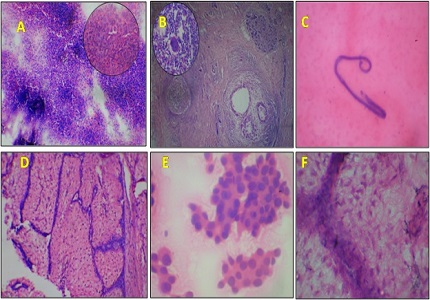A prospective study of the palpable lesions of the breast and the role of FNAC in these lesions with available histopathology methods
Abstract
Introduction: Benign as well as malignant breast lesions are quite common in Indian population. It is the second most common cancer site after cancer cervix. Fine-needle aspiration cytology (FNAC) is safe, reliable, and time saving outdoor procedure with little discomfort to the patient.
Objective: The current study was aimed to study the frequency of various breast lesions on FNAC in a tertiary care center and its histopathological correlation.
Methodology: Total of 217 cases of FNAC was conducted in the palpable lesions of the breast.
Result: Most of the lesions were noted in the left breast (123) lesions out of which 29 were malignant. The various benign neoplastic lesions seen were 81 patients. Fibroadenoma were found mostly in the age group of 21-30 years. 41 cases of fibrocystic disease found mostly in the age group of 31 to 50 years. The lymph node metastasis was seen in 5 patients with 35 to 55yrs of age. There were 71 benign neoplastic lesions and 21 cases of malignancy available for histopathology. FNAC was 80.9% sensitive and 95.89% specific in diagnosing malignant lesions.
Conclusion: A high sensitivity and a high positive predictive value proved that a positive FNAC in the breast means a definite diagnosis of the concerned pathology if compared with the final histology report. Thus, we have no hesitation in concluding that FNAC is a very important preliminary diagnostic test in palpable breast lumps and done by expert hands, the results show a high degree of correlation with the final histopathology report.
Downloads
References
2. Institute NC: SEER stat fact sheets: Breast cancer. 2008. [PubMed]
3. Giordano SH, Cohen DS, Buzdar AU, Perkins G, Hortobagyi GN: Breast carcinoma in men: a population-based study. Cancer. 2004 Jul 1;101(1):51-7. [PubMed]
4. Al Zahrani NM, Soomro S, Memon AG: Breast Cancer Diagnosis and Treatment of Prophetic Medicine Using Expert System. Journal of Information & Communication Technology 2010, 4(2):20-26.
5. Cancer CGoHFiB: Breast cancer and breastfeeding: collaborative reanalysis of individual data from 47 epidemiological studies in 30 countries, including 50 302 women with breast cancer and 96 973 women without the disease. The Lancet 2002, 360(9328):187-195.
6. Yager JD, Davidson NE: Estrogen carcinogenesis in breast cancer. New England Journal of Medicine 2006, 354(3):270-82. [PubMed]
7. Xue F, Willett WC, Rosner BA, Hankinson SE, Michels KB: Cigarette smoking and the incidence of breast cancer. Arch Intern Med. 2011 Jan 24;171(2):125-33. doi: 10.1001/archinternmed.2010.503. [PubMed]
8. Organization WH: Breast cancer: prevention and control. World Health Organization[Online] 2012.
9. Florentine BD, Staymates B, Rabadi M, Barstis J, Black A; Cancer Committee of the Henry Mayo Newhall Memorial Hospital. The reliability of fine-needle aspiration biopsy as the initial diagnostic procedure for palpable masses: a 4-year experience of 730 patients from a community hospital-based outpatient aspiration biopsy clinic. Cancer. 2006 Jul 15;107(2):406-16.
10. Arisio R, Cuccorese C, Accinelli G, Mano MP, Bordon R, Fessia L: Role of fine‐needle aspiration biopsy in breast lesions: Analysis of a series of 4,110 cases. Diagnostic cytopathology 1998, 18(6):462-467.
11. Ciatto S, Cecchini S, Grazzini G, Iossa A, Bartoli D, Cariaggi M, Bulgaresi P: Positive predictive value of fine needle aspiration cytology of breast lesions. Acta cytologica 1988, 33(6):894-8. [PubMed]
12. Khemka A, Chakrabarti N, Shah S, Patel V: Palpable breast lumps: Fine-needle aspiration cytology versus histopathology: A correlation of diagnostic accuracy. The internet journal of surgery 2009, 18(1).
13. Tiwari M. Role of fine needle aspiration cytology in diagnosis of breast lumps. Kathmandu Univ Med J (KUMJ). 2007 Apr-Jun;5(2):215-7. [PubMed]
14. Ariga R, Bloom K, Reddy VB, Kluskens L, Francescatti D, Dowlat K, Siziopikou P, Gattuso P: Fine-needle aspiration of clinically suspicious palpable breast masses with histopathologic correlation. The American journal of surgery 2002, 184(5):410-413.
15. Walker S: A randomized controlled trial comparing a 21 G needle with a 23 G needle for fine needle aspiration of breast lumps. Journal of the Royal College of Surgeons of Edinburgh 1998, 43(5):322-323.
16. Yeoh G, Chan K: Fine needle aspiration of breast masses: an analysis of 1533 cases in private practice. Hong Kong Med J. 1998 Sep;4(3):283-288. [PubMed]
17. Silverman JF, Elsheikh TM, Singh HK: The role of fine needle aspiration cytology of the breast in the core biopsy era. Pathology Case Reviews 2007, 12(1):44-48.
18. Kocjan G: Fine needle aspiration cytology: diagnostic principles and dilemmas: Springer Science & Business Media; 2006.
19. Ishikawa T, Hamaguchi Y, Tanabe M, Momiyama N, Chishima T, Nakatani Y, Nozawa A, Sasaki T, Kitamura H, Shimada H: False-positive and false-negative cases of fine-needle aspiration cytology for palpable breast lesions. Breast cancer 2007, 14(4):388-392.
20. Mansoor I, Jamal AA: Role of fine needle aspiration in diagnosing breast lesions. Saudi medical journal 2002, 23(8):915-20. [PubMed]
21. Zanconati F, Bonifacio D, Falconieri G, Di Bonito L: Role of fine‐needle aspiration cytology in nonpalpable mammary lesions: A comparative cytohistologic study based on 308 cases. Diagnostic cytopathology 2000, 23(2):87-91.



 OAI - Open Archives Initiative
OAI - Open Archives Initiative


